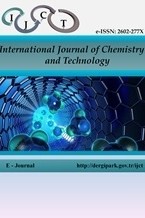Quantitative modeling for prediction of boiling points of phenolic compounds
Quantitative modeling for prediction of boiling points of phenolic compounds
Phenolic compounds, Boiling point QSPR, MLR, Prediction set,
___
- 1. Michałowicz, J.; Duda, R.O.W. Water. Air. Soil. Pollut. 2005,16, 205-222.
- 2. Todeschini, R.; Gramatica, P.; Provenazi, R.; Marengo, E.; Chemom. Intell. Lab. Syst. 1995, 27, 221-229.
- 3. Gharagheizi, F.; Mirkhani, S. A.; Ilani-Kashkouli, P.; Mohammadi, A. H.; Ramjugernath, D. Richon, D.; Fluid Phase Equilib. 2013, 354, 250-258.
- 4. Katritzky, A. R.; Mu, L.; Lobanov, V. S. J. Phys. Chem. 1996, 100, 10400-10407.
- 5. Yi-min, D.; Zhi-ping, Z.; Zhong, C.; Yue-fei, Z.; Ju-lan, Z.; Xun L. J. Mol. Graphics. Modell. 2013, 44, 113-119.
- 6. White, C.M. J. Chem. Eng. Data. 1986, 31, 198-203.
- 7. Smeeks, F.C.; Jurs, P.C. Anal. Chim. Acta. 1990, 233, 111-119.
- 8. Admire, B.; Lian, B.; Yalkowsky, S. H. Chemosphere. 2015, 119, 1436–1440.
- 9. Shuai, D. ;Wen, S.; Li, Zhao. Int. J. Refrig. 2016, 63, 63–71.
- 10. Liangjie, J.; Peng B. Chemom. Intell. Lab. Syst. 2016, 157, 127–132.
- 11. Ramane, H. S.;• Yalnaik, A. S. J. Appl. Math. Comput. 2017, 55, 1–2, 609–627.
- 12. Varamesh, A.; Hemmati-Sarapardeh, A.; Dabir, B.; Mohammadi, A.H. J. Mol. Liq, 2017, 242, 59-69.
- 13. Arjmand, F.; Shafiei, F. J. Struc. Chem. 2018, 59, 3, 748-754.
- 14. Katritzky,A. R.; Maran, U.; Lobanov,V. S.; Karelson, M. J. Chem. Inf. Comput. Sci. 2000, 40, 1-18.
- 15. Katritzky, A. R.; Lobanov,V. S.; Karelson, M. Chem. Soc. Rev. 1995, 24, 279-287.
- 16. Mackay, D.; Shiu,W.Y.; Ma, K.C.; Lee, S.C. Handbook of Physical-Chemical Properties and Environmental Fate for Organic Chemicals, CRC Press Taylor & Francis Group 6000 Broken Sound Parkway NW, Suite 300 Boca Raton, FL 33487-2742.Vol III, 2006.
- 17. Kennard, R.; Stone, L.A. Technometrics. 1969, 11, 137-148.
- 18. HyperChem 6.03 Package. Hypercube, Inc., Gainesville, Florida, USA, 1999, software available at: http://www.hyper.com.
- 19. Gaber, M.M. Scientific Data Mining and Knowledge Discovery: Principles and Foundations; Springer Heidelberg Dordrecht London, Berlin, 2009.
- 20. Talete Srl. Dragon for Windows (Software for Molecular Descriptor Calculation) Version 5.5 Milano, Italy, 2007, software available at: http://www.talete.mi.it.
- 21. Leardi, R.; Boggia, R,; Terrile, M. J. Chemom. 1992, 6, 267-281.
- 22. Todeschni, R.; Ballabio, D.; Consonni, V.; Mauri, A.; Pavan, M. 2009. Mobydigs – version 1.1 – Copyright TALETE Srl.
- 23. Todeschini R.; Maiocchi A.; Consonni, V. Chemom. Int. Lab. Syst. 1999, 46, 13-29.
- 24. Tropsha, A.; Gramatica, P.; Gombar, V. K. QSAR Comb. Sci. 2003, 22, 70-77.
- 25. Golbraikh, A.; Tropsha, A. J. Mol. Graph. Model. 2002, 20, 269-276.
- 26. Yu, X. L.; Yi, B.; Yu,W. H.; Wang, X. Y. Chem. Pap. 2008, 62, 623-229.
- 27. Netzeva, T.I.; Worth, A.P.; Aldenberg, T.; Benigni, R.; Cronin, M.T.D.; Gramatica, P.; Jaworska, J.S.; Kahn, S.; Klopman, G.; Marchant, C.A.; Myatt, G.; Nikolova-Jeliazkova, N.; Patlewicz, G.Y.; Perkins, R.; Roberts, D.W.; Schultz, T.W.; Stanton, D.T.; vande Sandt, J.J.M.; Tong, W.;Veith, G.; Yang, C. Altern. Lab. Anim. 2005, 33, 155–173.
- 28. Gramatica, P.; Cassani, S. Roy, P. P. Kovarich, S.; Yap. C. W. Papa, E. Mol. Inform. 2012, 31, 817-835.
- 29. Eriksson, L.; Jaworska, J.; Worth, A.P.; Cronin, M.T.D.; McDowell, R.M.; Gramatica, P. Environ. Health. Perspect. 2003, 111, 1361-1375.
- 30. Jaiswal, M.; Khadikar, P.V.; Scozzafava,A.; Supuran, C.T. Bioorg. Med. Chem. Lett. 2004, 14, 3283-3290.
- 31. Todeschini, R.; Consonni, V. Molecular Descriptors for Chemoinformatics; Wiley-VCH: Weinheim, Germany, 2009.
- 32. Gramatica, P.; Navas, N.; Todeschini, R. Trends Anal. Chem. 1999b, 18, 461-471.
- 33. Randic, M.; Razinger, M. J. Chem. Inf. Model. 1995, 35, 140-147.
- 34. Mitra I.; Saha A.; Roy K. Mol. Simul. 2010, 36, 1067-1079.
- 35. Ray, S.; Sengupta, C.; Roy K. Cent. Eur. J. Chem. 2007, 5, 1094-1113.
- 36. Randic, M. J. Chem. Inf. Model. 2001, 41, 607-613.
- 37. Abbasi, M.; Sadeghi-Aliabadi, H.; Amanlou, M. J. Pharm. Sci. 2017, 25, 1-17.
- 38. Consonni,V.; Todeschini, R.; Pavan, M. J. Chem. Inf. Comput. Sci. 2002, 42, 682-692.
- 39. Consonni,V.; Todeschini, R.; Pavan, M.; Gramatica, P. J. Chem. Inf. Comput. Sci. 2002, 42, 693-705.
- Yayın Aralığı: Yılda 2 Sayı
- Başlangıç: 2017
- Yayıncı: İbrahim DEMİRTAŞ
Adsorption of basic red 2 dye by activated biomass charcoal in batch and column systems
Bilal ACEMİOĞLU, Neslihan KARATAŞ, Melike Hilal GÜLER, Murat ERTAŞ, Mehmet Hakkı ALMA
Rafet YILMAZ, Turgay ÖZMEN, Tahir ÇAKIR
Cytotoxic activity of zinc oxide/titanium dioxide nanoparticles on prostate cancer cells
Ayca TAS, Nese KEKLİKCİOGLU CAKMAK, Tugba AGBEKTAS, Yavuz SİLİG
Quantitative modeling for prediction of boiling points of phenolic compounds
Soumaya KHEROUF, Nabil BOUARRA, Djelloul MESSADİ
Recombinant human G-CSF production as a protein based drug candidate for hematology and oncology
Yasemin BOZKURT, Sema BİLGİN, Seçil ERDEN, İsmail Furkan TURAN, İsa GÖKÇE
Muhammed Can ÖZDEMİR, Ömer SEVGİLİ, İkram ORAK, Abdülmecit TÜRÜT
